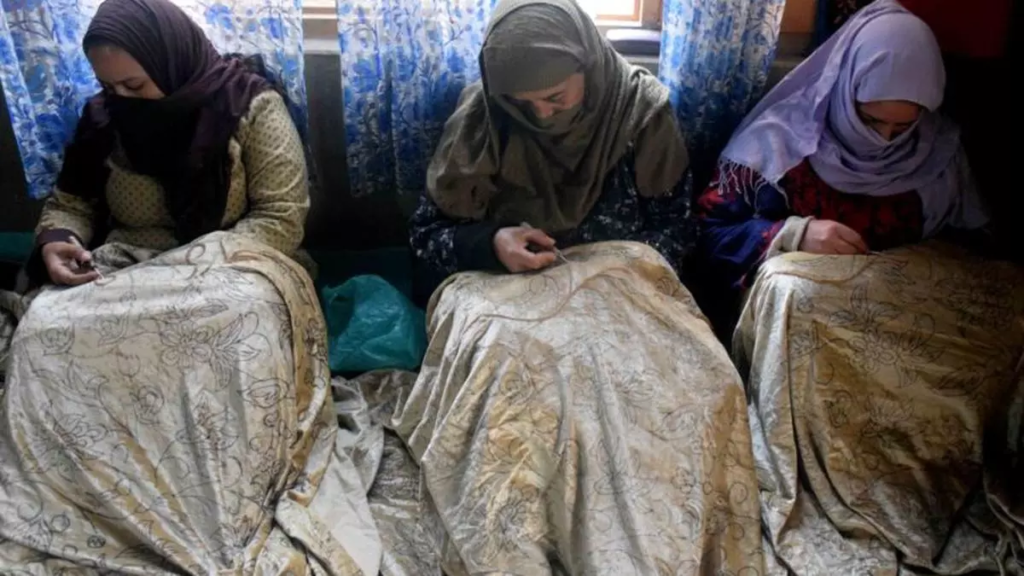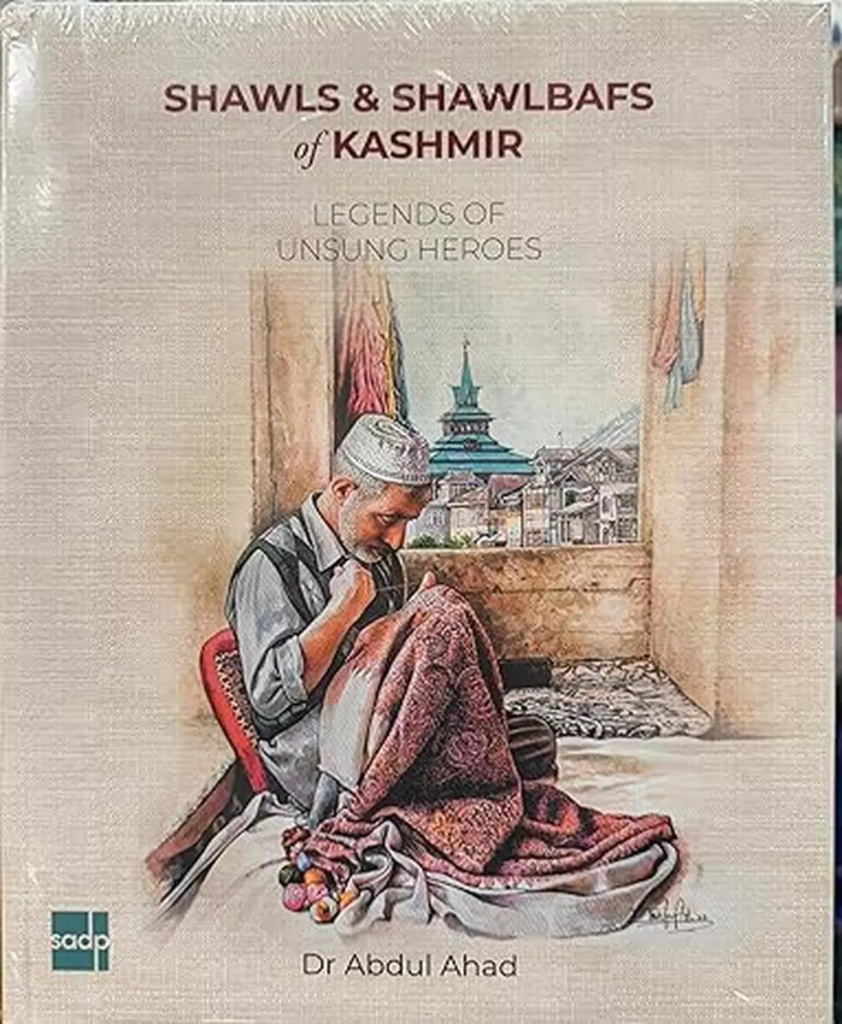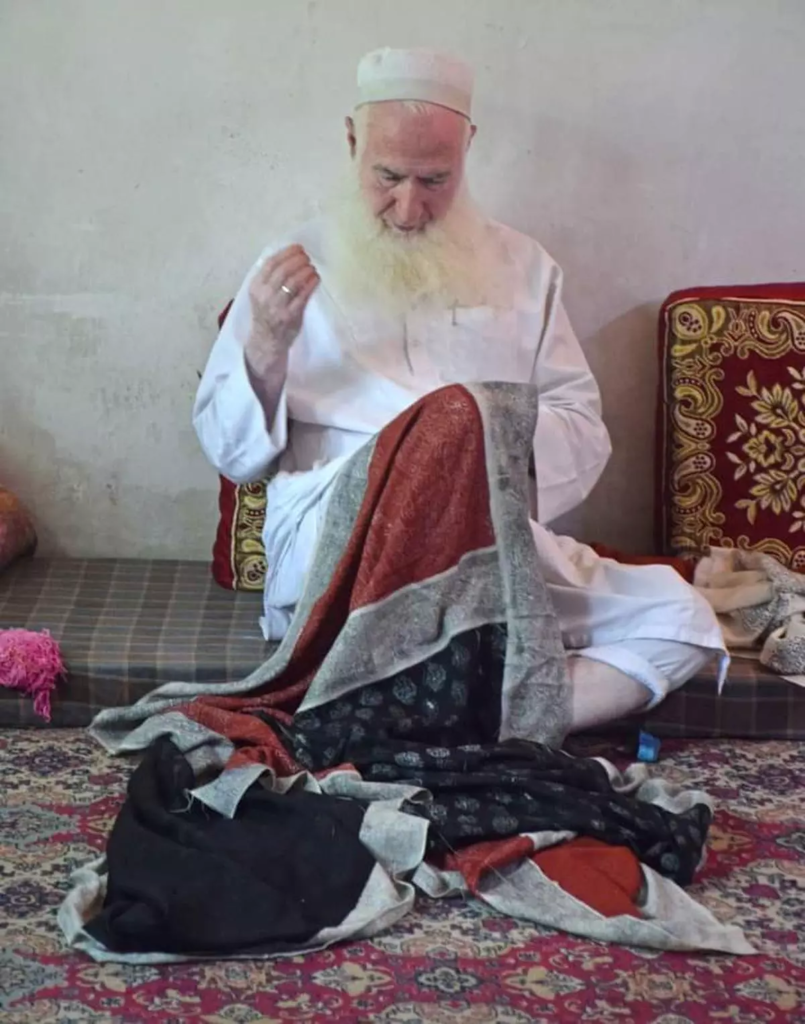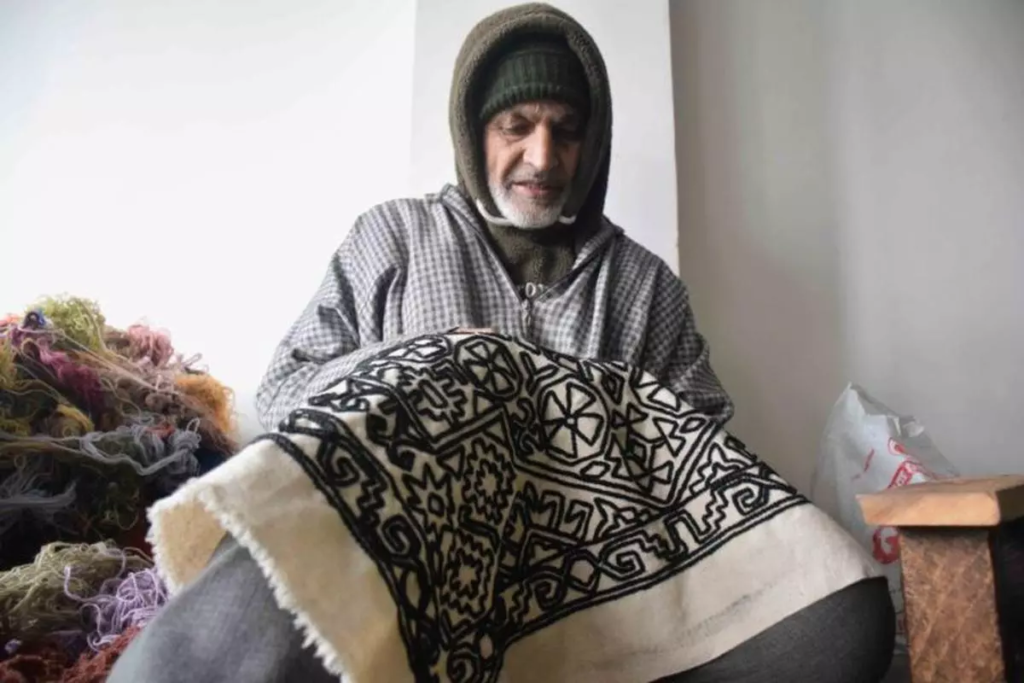JAMMU & KASHMIR :
Abdul Ahad’s nuanced book explores Kashmir’s artisans’ legacy, offering profound insights on resilience amid enduring turmoil.

Kashmiri women at work on crewel embroidery. | Photo Credit: Jaspreet Kaur
In the annals of Kashmir’s tumultuous history, the Zaldagar agitation of 1865 is a watershed moment. On April 29, 1865, the community of Shawlbafs (traditional weavers of the famed Kashmiri shawl) hit the streets of Zaldagar in Srinagar in a peaceful protest against the high taxes levied upon them by the Dogra rulers. In the mayhem and stampede that ensued when the Dogra Army attacked the unarmed protesters, as many as 28 Shawlbafs drowned and scores were injured.
The Zaldagar rebellion, as it came to be known, was not just a revolt against immediate grievances. It was the first indigenous political movement of modern South Asia, a precursor to the broader struggles against colonial and feudal oppression. Though the Shawlbafs are often relegated to the shadows of history, their defiance at Zaldagar lit a flame that would ignite countless hearts, shaping the resistance ethos of Kashmir for generations to come.
Who are these unsung heroes? How does the painstaking labour of these artisans elevate the Kashmiri shawl to a symbol of global prestige? In what ways does a labour uprising from the 19th century continue to resonate within the veins of Kashmir’s political discourse today?
The former bureaucrat-turned-historian Dr Abdul Ahad deftly navigates these questions in his most recent book Shawls and Shawlbafs of Kashmir: Legends of Unsung Heroes,which sheds light on the enduring legacy of these artisans and the historical events that continue to shape the cultural and political fabric of Kashmir. Well-researched and richly embellished, this book is a painstaking exploration of the origin of the Kashmiri shawl as an indigenous product and the commitment and craftsmanship of its makers, the Shawlbafs.
Embedded within Kashmir’s cultural tapestry, this cottage industry, now on the precipice of oblivion, finds a voice in these pages, as the text meticulously chronicles its decline and the indelible mark it has left upon the region’s historical and socio-cultural landscape. The book serves not merely as a chronicle but as a poignant requiem for an artisanal legacy that teeters on the brink of extinction.
The shawl as an emblem of Kashmiri identity
Dr Ahad’s groundbreaking work fundamentally challenges the narrative that positions the Kashmiri shawl as an exotic import, alien to the indigenous cultural and artistic milieu of Kashmir. In Chapter One titled “Birth of an Occupation”, while departing from the perspectives presented in earlier works like Frank Ames’ The Kashmir Shawl and Its Indo French Influence and Parviz Nemati’s Shawls of the East: From Kerman to Kashmir, both of which suggested a foreign origin for this craft, Dr Ahad argues that the shawl is not merely a fabric but a profound articulation of Kashmiri artistic identity, deeply interwoven with the region’s socio-cultural fabric from its inception.

Shawls and Shawlbafs of Kashmir: Legends of Unsung Heroes / By Dr Abdul Ahad / South Asia Distributors and Publishers, 2024 / Pages: 100 / Price:Rs.6,250
Archaeological evidence shows that the art of shawl-weaving in Kashmir began in Burzahom, Srinagar, over 5,000 years ago. Tiles found in Harwan, Srinagar, and Hutmur, Anantnag, suggest that people in Kashmir at that time were highly skilled in weaving fine, transparent cloth. These discoveries highlight the long and rich tradition of weaving in the region. The shawl, Dr Ahad asserts, is emblematic of the Kashmiri ethos, reflecting the intricate interplay of history, tradition, and artistry that defines the region, thereby reasserting its rightful place as an indigenous craft that is not a derivative of Central Asian influences.
In the chapters “Shawl Karkhanas: Avenues of Employment” and “Shawl Trade: A Lucrative Business”, Dr Ahad provides a comprehensive analysis of the wool industry in Kashmir, presenting it as a cornerstone of both economic and social development. He elucidates how shawl karkhanas (woollen weaving workshops) functioned as traditional special economic zones, providing extensive employment opportunities and facilitating the socio-economic upliftment of rural and urban Kashmir. Dr Ahad’s documentation highlights how the integration of these industries into broader economic frameworks not only spurred local development but also positioned the shawl trade as a significant contributor to the region’s prosperity.

Haji Ghulam Rasool Khan, a master craftsman from Srinagar who was awarded the Padma Shri for reviving the art of Jamawar patchwork. | Photo Credit: Jaspreet Kaur
The unsung Shawlbafs
In the forthcoming chapters, Dr Ahad unveils the tribulations of Kashmir’s artisans—its weavers, embroiderers, designers, spinners, and craftsmen. Through a comprehensive analysis, he shows us how their labour not only influences the socio-economic fabric of Kashmir but also feeds into the region’s political discourse of dissent. In this way, he highlights the historiographical neglect of the shawlbafs, whose lived experiences and socio-economic struggles have been conspicuously absent from historical narratives. He writes: “The productive and creative activities of Shawlbafs—who have carried them out against heavy odds to eke out their existence, improvise their skills, increase the quality of shawl products, and, thereby, build the edifice of Kashmiri society and the soul of its cultural stockpile—have regrettably been denied (and are being denied even today) the space they deserve in the history of Kashmir.”
Dr Ahad posits that the significant surge in population, coupled with the expansion of the commodity economy, catalysed a profound disjunction between industry and agriculture, as well as a bifurcation of artisans from the agrarian populace. This transformation, driven by the burgeoning bazaar economy, engendered a reliance of artisans on intermediaries and merchants, thereby undermining the autonomy of production.

Abdul Rashid Bhat, the famed “chain-stitch master” from Tengpora, Srinagar. | Photo Credit: Jaspreet Kaur
The shawl industry languished under the weight of relentless taxation imposed by successive regimes. Except the benevolent reign of Zain-ul-Abideen, the Mughal, Sikh, and Afghan dynasties exacted crippling levies upon the shawlbafs, driving these artisans, the very lifeblood of the craft, to the brink of destitution. Their impoverishment and subsequent migration to alternate livelihoods marked the slow erosion of a once-flourishing tradition. A Persian couplet in the book poignantly captures the tragedy of Kashmir and its workforce during the Afghan rule:
“Purseedum az khadabiye gulshan zi baghban Afghan kasheed, guft ki Afghan khadabiye kardd (When the poet asked the gardener who laid waste to his garden/ Drawing a deep sigh, he replied: ‘Afghan’)”
This book, ostensibly a treatise on Kashmiri craftsmanship, is also a poignant memoir chronicling the region’s turbulent politics. It dissects how labour strife and uprisings laid bare the yearning for Kashmiri sovereignty, a yearning tragically marred by the relentless machinations of political expediency, which plunged the Valley into perennial turmoil. The narrative captures the essence of the Zaldagar Rebellion of 1865 which ignited a wave of cooperative movements that reverberated far beyond Kashmir’s borders, their ideological ripples echoing across distant geographies.
It also meticulously charts the region’s descent from a bastion of cultural and historical significance into a landscape marred by chaos, anarchy, and oppressive foreign occupations. Through a nuanced exploration of centuries of political resistance and agitation, the book captures Kashmir’s relentless struggle to reclaim its lost identity and agency, offering a profound commentary on the resilience of a people amid enduring turmoil.
This book sheds light on the often-overlooked artisans whose skilled hands have brought international fame to the humble shawl, from gracing the shoulders of VVIPs at events like the FIFA World Cup to driving an industry worth Rs.5,000 crores annually. It is a poignant call to recognise the quiet resilience of these unsung heroes, whose craftsmanship speaks louder than their voices, yet remains largely unheard. Shawls and Shawlbafs of Kashmir is a remarkable ode to Kashmiri culture, seamlessly weaving history, artistry, and tradition into a compelling narrative.
Bilal Ahmad Wagay teaches Politics at Government College, Beerwah.
source: http://www.frontline.thehindu.com / Frontline / Home> Books> Book Review / by Bilal Ahmad Wagay / September 20th, 2024








